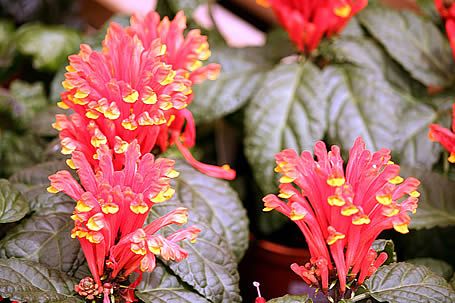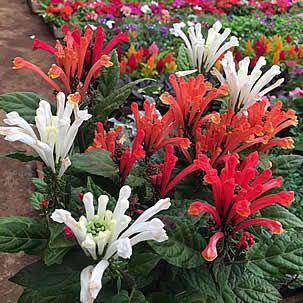The Scarlet Skullcap (Scutellaria costaricana) is a sub-shrub plant with ornamental foliage and flowering, native to Costa Rica and Panama, and still not widely spread. It has a branched stem, purplish in color, and dark green to bronzed, oval leaves that are opposite and with well-defined veins.
The inflorescence is a terminal raceme, with numerous and long tubular flowers, with a recurved apex, resembling a helmet or mask. The typical color is red, with two lips, the lower one being yellow on the inside, but the flowers can be more pink or orange, and even yellow or white, depending on the variety. The flowering is very attractive to butterflies and hummingbirds.

Flowers that resemble small torches of fire all year round, with a plant that does not require full sun. It’s a delight for landscapers to use such plants, especially when clients insist on having flowers in less sunny locations.
The Scarlet Skullcap may sound exotic and it is still quite rare to find it in garden centers and nurseries, yet, it’s worth looking for to use in indoor environments or in partial shade in the garden. Although it does not require direct sunlight, this species appreciates good light, which can be through the gentle morning sun, or filtered light throughout the day.
This translates into versatility as well, making it possible to be used in mass plantings and borders in the garden, especially protected ones, covering small woods for example, or outlining walled corridors. In addition, it decorates shopping malls, offices, living rooms, and can be planted in pots and planters.

It should be cultivated in partial shade or diffused light, in fertile, drainable soil, enriched with organic matter, and kept consistently moist. It thrives in the heat and humidity of the tropics, flowering throughout the year in warm regions. Avoid letting the soil dry out between waterings.
It does not tolerate frost or intense cold in winter, and in areas prone to such weather, like in southern Brazil, it is advisable to cultivate it in pots and take it indoors to well-lit spaces during winter. Under temperate climates, flowering concentrates in spring and summer. Protect the plant from dry air, avoiding winds and air conditioning. It can be propagated by cutting herbaceous branches and by seeds.


